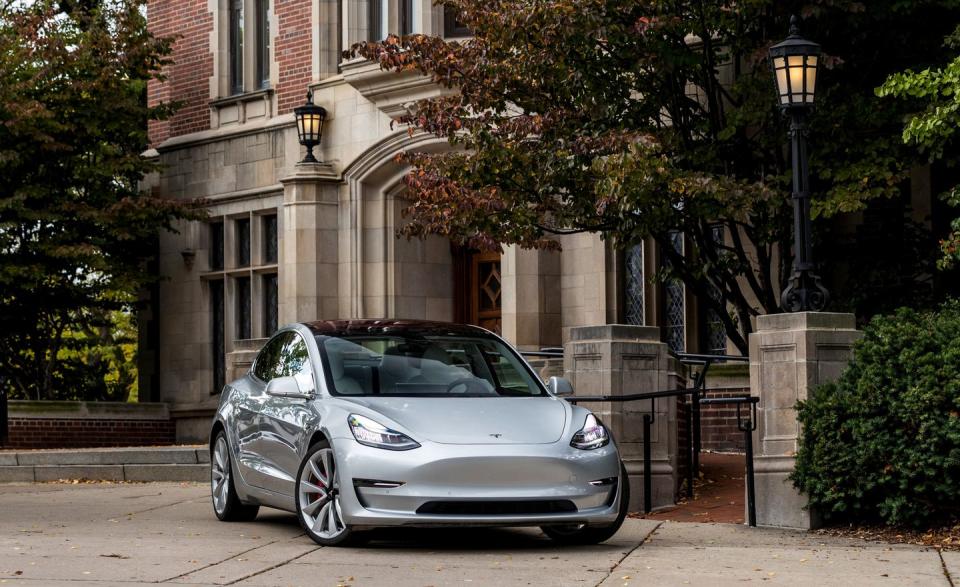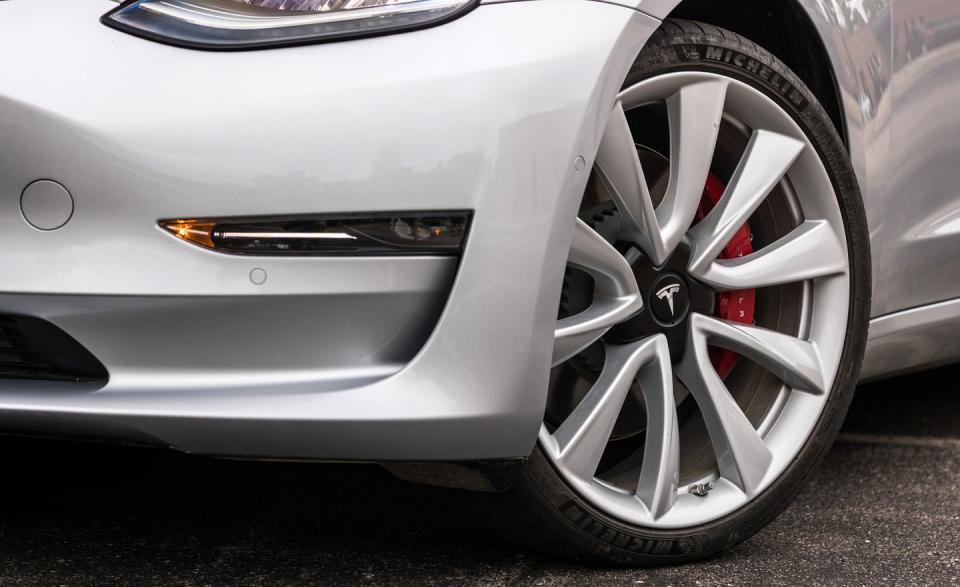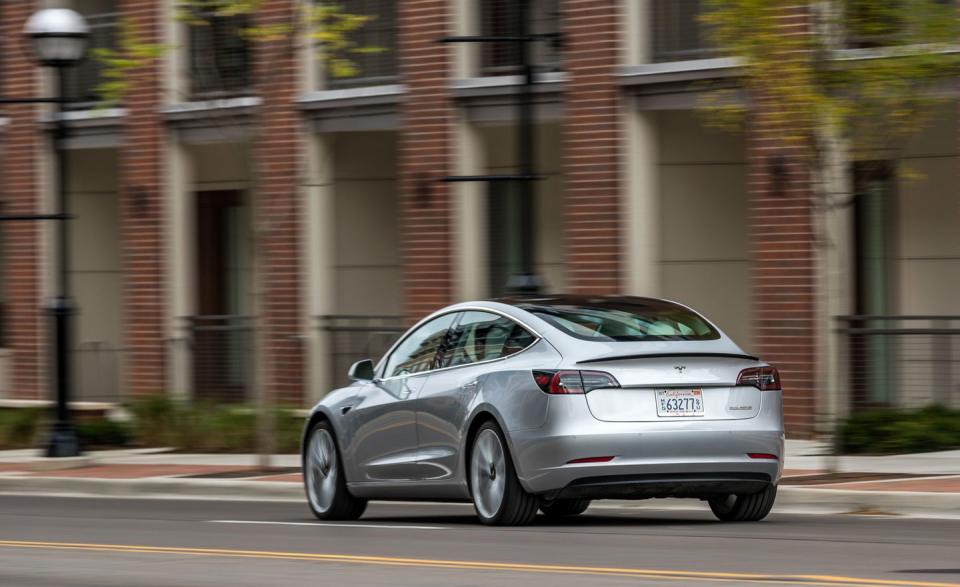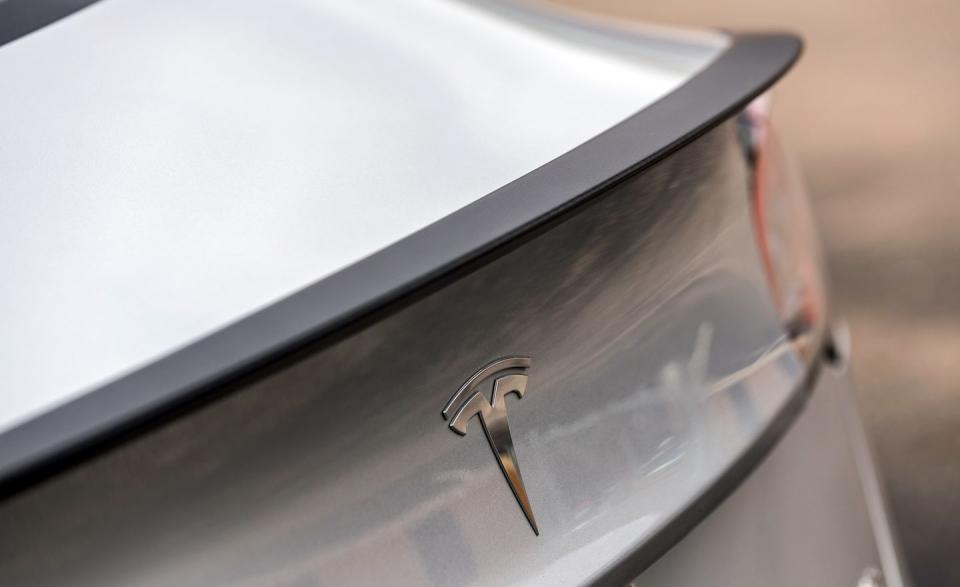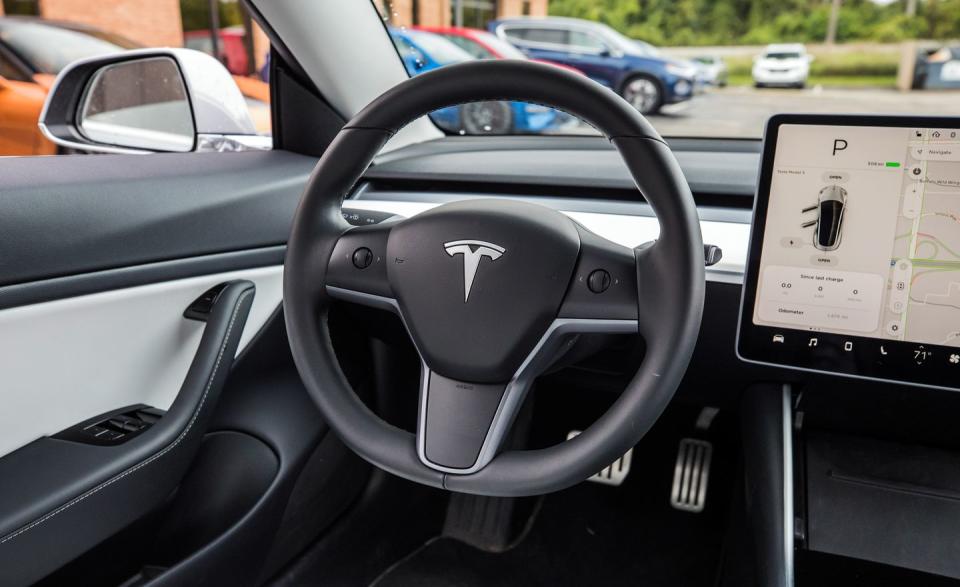2018 Tesla Model 3 Performance Rules the Passing Lane
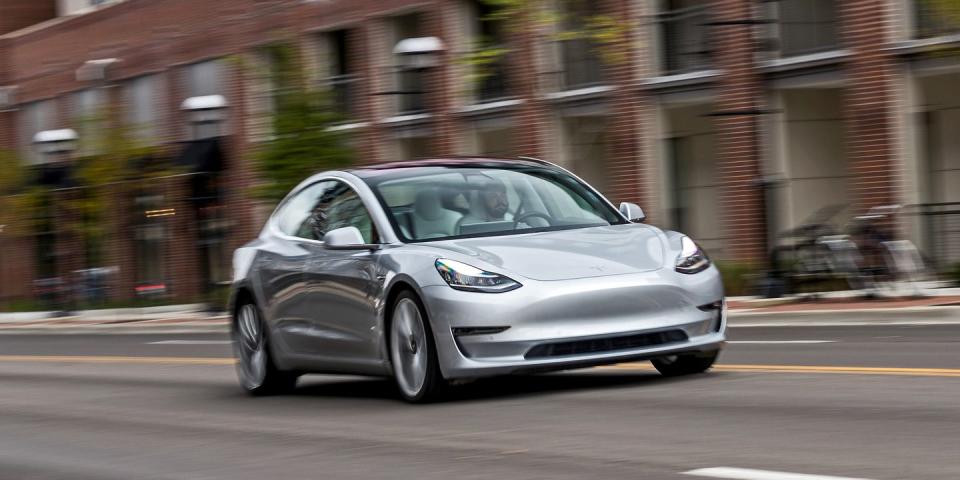
Now that Tesla has achieved its production target for its Model 3, albeit belatedly, it has moved into the passing lane in the sales race. Tesla's 5000-cars-a-week production equates to just over 20,000 deliveries a month, a figure many midsize and compact sedans with heavy advertising budgets behind them can only dream about anymore, and well beyond the rate for comparable sports sedans.
A few caveats apply to this impressive achievement, including that most of these sales are long-delayed deliveries of cars ordered up to two years ago and reflect pent-up demand, and that-so far-the Model 3s sold are priced far beyond the promised, $35,000 base price. If Tesla can sustain this pace through all of 2019 while adding more affordable versions, it truly will have arrived as a mass-market car company, if not necessarily a profitable one. Still, the Model 3 is already outselling its rivals in the $50,000-plus range, not to mention every other electric car offered in America, and by wide margins. Competitors are bringing new EVs into the market at a rapid pace, but the buying public already seems to equate "electric car" with Tesla in the same way it associates "hybrid" with Toyota's Prius.
Let's Add Another Motor!
For driving enthusiasts, the most appealing expansion of the Model 3 range is the car tested here, the Dual Motor Performance, which substantially increases the Long Range Dual Motor's horsepower output from 346 to 450 ponies. Both draw on the same 80.5-kWh lithium-ion battery pack that features in the Long Range model and was the only one available until the 220-mile Mid Range variant was announced on October 18th. (A smaller battery will be used in the as-yet-unavailable standard model.) The Dual Motor, all-wheel-drive setup is now standard on all Long Range Model 3s.
This Performance model earns a 310-mile range estimate from the EPA, but it also caters to the driver who'd prefer to direct that energy toward making haste rather than distance. It's the electric-car analog to the BMW M3 or the Alfa Romeo Giulia Quadrifoglio; the all-wheel-drive aspect makes one think Audi, whose 444-hp RS5 Sportback departs from segment norms only in having a hatch rather than a trunk. Whether you compare external and interior dimensions, price (in the $70,000 to $80,000 range), or objective performance, this Model 3 variant fits right in amongst that group of driver-focused sports sedans. The only American-built contender is the aging Cadillac ATS-V. And in crucial measures of mid-range acceleration in the 30-to-70-mph zone where most Americans spend most of their driving time, the Tesla Model 3 is poised in the passing lane, left signal blinking to suggest that your M/AMG/Audi Sport/V-badged four-door ought to move over and let the future happen.
Without Track Mode
We've already reviewed the Model 3 in an instrumented test of the most affordable version then available, so go to that story for more discussion of the basics and we'll focus here on the driving experience expected of any car wearing a Performance moniker.
Our first exposure to the Performance model came on an autocross course, where Tesla invited us to assess its new Track driving mode, complete with drifting ability. That mode, which enables a more aggressive thermal-management strategy and otherwise largely affects cornering behavior near the limits of adhesion, is available as a software download to purchasers who opt for the $5000 Performance Upgrade package (which is added on top of the Dual Motor Performance trim level). Also included are 20-inch wheels wearing Michelin Pilot Sport 4S tires; brakes with larger, stiffer, red-painted calipers; a modest carbon-fiber decklid spoiler; and aluminum pedals. The car tested here had this upgrade package, but the Track-mode software had not been installed.
Many drivers have come to understand that electric cars accelerate well, thanks to their motor's ability to deliver maximum torque from a standstill. In ordinary daily driving, this is most evident in the Model 3 Dual Motor Performance not so much when pulling away from a stop-although if you insist on being the first driver to cross the intersection, you can be-as when vying for a position in commuter traffic on a major artery, merging onto a highway, or when passing a slower vehicle on a two-lane road. Here, it's not just the instant torque, but also not having to wait for a downshift (there aren't any with the Tesla's direct-drive reduction ratio) that produces stunning real-world responses. This Model 3 needed only 1.4 seconds to leap from 30 to 50 mph and just 2.0 seconds to get from 50 to 70. Never mind other sports sedans-they're not competitive by this measure. This Tesla's mid-range acceleration tops the performance of 700-hp sports cars like the Chevrolet Corvette ZR1 and Porsche 911 GT2 RS, in which there's a moment's delay while automatic transmissions downshift and engines rev up. And the Tesla does it without drama beyond the alarming way it pushes you back into the seat as the car closes on any traffic ahead. There's no jerk and no roar-plant your foot on the accelerator and it simply goes.
We measured zero-to-60-mph acceleration at 3.5 seconds, 1.6 quicker than the rear-drive Long Range model tested earlier. The Model 3 Dual Motor Performance ran a quarter-mile in 12.1 seconds at 114 mph. We clocked the BMW M3-the performance bogie for Tesla-at 4.0 seconds to 60 mph and 12.2 in the quarter-mile. The other leading sports sedans have ranged between 3.6 and 3.9 seconds to 60 mph while running their quarter-miles in 11.9 to 12.2 seconds.
Like other EVs, the Model 3's advantage fades as velocity rises-that's part of the disadvantage of not having multiple transmission ratios-but the internal-combustion sports sedans don't really start gaining until you get to 100 mph, which the Performance hits in 8.9 seconds. All the aforementioned cars reach that mark a few tenths of a second earlier, led by the Giulia Quadrifoglio at 8.1, and all claim higher top speeds than the Tesla, ranging from the Cadillac's 160-plus to the Alfa's 191 mph. With the Performance Upgrade package, the Model 3 is governed to 153 mph.
Cornering and Stopping
The Tesla trailed its sports-sedan rivals by only a small increment on the skidpad, delivering a strong 0.95 g of lateral grip against the Alfa at 0.99, the M3 at 0.98, and the Mercedes-AMG C63 S at 0.97. The Audi RS5 two-door coupe matched the Tesla's 0.95 g. Our test car exhibited moderate understeer during the exercise, and the Model 3 isn't as eager to dive into a corner as most sports sedans, although there's a Sport steering mode that ups effort levels. The low-mounted mass of the battery helps the Tesla maintain a flat cornering attitude that's effective on a track and even more impressive on our favorite stretches of country road, but overall suspension refinement on rippled pavement lags a little, perhaps because there's so much mass to cope with and the wheels are big.
The Model 3 stopped from 70 mph in 147 feet where all the gas-burning competitors needed at least 150. The Tesla produces strong deceleration from the regenerative system as soon as the driver lifts off the accelerator, even before applying the left pedal to bring the friction brakes into play. Also credit the grippy performance tires and upgraded brakes-the regular rear-drive Model 3 with the standard brakes and shod with all-season tires on 18-inch wheels produced only 0.84 g of lateral grip and needed 176 feet to stop from 70 mph.
That the Model 3 won't come to a full stop using only regenerative deceleration to enable one-pedal driving annoyed those among us who've come to love that aspect of some electric cars, but the regen is strong enough that you really only need the left pedal in stop-and-go situations. The more usual ebb and flow of heavy traffic is easily managed without resorting to the brake pedal, which operates the friction brakes and benefits from being devoted to that task, absent the often awkwardly managed blending found in other electrics and hybrids.
The second motor and other upgrades inevitably add mass, such that this car weighed 4087 pounds, or 190 more than the rear-drive Model 3 tested earlier, which is already hefty for the segment. Aside from the Audi with its all-wheel-drive hardware, competitive sports sedans weigh 250 to nearly 500 pounds less (the M3 is a relatively svelte 3651 pounds). And the second motor seriously intrudes on the front cargo area, which shrinks from a space where you could stash a couple of backpacks to barely enough room to stow extension cords and adapters for that inevitable day that you need to charge the Model 3 somewhere other than at a Tesla Supercharger station. The EPA says it'll take 10 hours to fully recharge a completely depleted battery at 240 volts; Tesla fan sites say it'll take less than two hours at a Supercharger, and half that if you're willing to settle for 80 to 90 percent of a full battery.
Digital Demeanor
The numbers tell you that this is one electric car that can run with the best gasoline models. What they don't tell you is how different it feels in regular use. There's no "mastering a machine" element to driving it, and depending on one's receptivity to change, it can either amaze or disappoint while delivering its performance. To what extent do you associate driving enjoyment with physical engagement like shifting gears, applying a brake pedal, or listening for the exhaust note to change? You still need to manage load transfer and your line through a corner. There's still a detectable difference between a smooth driver and an incompetent hack. And there are still sensations through your fingers and the seat that communicate what's happening down there where the tires and pavement interact. But there's also an undeniable video-game aspect, a virtual-reality sensation that some interpret as "wow, it's the future" and others read as "this isn't driving in the way I've grown to love driving." That's all without even engaging the semi-autonomous driving features that reside in the $5000 Enhanced Autopilot option on this car.
There is one digital driver aid we'd appreciate: When you're fully engaged in exploiting this car's abilities, the information displayed on the central touchscreen, ordinarily easily read with a peripheral glance, takes too much time to register. All Model 3s would benefit from a head-up display (HUD), but the Performance version especially needs it. Speed and driving mode, at least, should be easier to read without glancing away from the road ahead, and the display's nifty depiction of surrounding traffic-a boon especially at night-could be easier to access, too. A HUD would seem like a better investment of engineering effort than gimmicks such as the "Santa mode" or replacing the road map with a view of Mars.
Getting What You Pay For?
Whatever you think of the Model 3's exterior design (some among us have called it "not pretty" while those with the warmest regard for the shape get no more impassioned than to suggest it's "not bad"), we've also noted that Teslas in general are not assembled to the high standards of the luxury automakers with which they compete. This particular example was one of the best we've seen with respect to exterior panel fits, with evenly spaced gaps except around the front, although these gaps were no tighter than those on Detroit pony cars-no one's ideal. And the interior just plain isn't that of a near-$80,000 sedan. Although the Dual Motor comes with "premium" interior trim compared with the as-yet-unseen base car, and this one was executed in white (another $1000 upcharge), the materials and assembly quality were barely competitive with sedans that cost half as much. Where the European cars generally excel with rich interior furnishings featuring aluminum, carbon-fiber, wood, and leather, the Model 3's starkly under-decorated cabin seems utilitarian at best. It doesn't measure up to a Mazda 3 let alone a BMW 3-series, and the Audi and Mercedes contenders stand a step higher on the ladder.
The reliance on the touchscreen for nearly all controls seems off-putting for only a short while-the quickly responsive screen rarely frustrates, doing what you ask the first time, and the menus are logical and easy to figure out. Still, that screen is really all the "décor" present in the cabin, so it's like sitting in a bare living room furnished with nothing more than a few chairs and a giant high-def TV. Speaking of sitting-the Model 3's seats are comfortable enough for commuting, but short on thigh support and side bolstering. Any car that can brake and corner at these levels really needs a more supportive seat.
Tesla pricing seems to be subject to nearly as many updates as its operating software, but at the time we drove the car, its window sticker started with the (nonexistent) Model 3 base price of $36,200, then adds motors and options from there. Bottom line, the absolute cheapest you can get a Model 3 Dual Motor Performance for is $65,200. Adding another $5000 for the Performance Upgrade package, $1500 for silver metallic paint, $1000 for the black and white interior, and $5000 for Enhanced Autopilot, brings the bottom line to $77,700. That's in line with other premium sports sedans, though the makers of conventional cars offer longer lists of options to make their cars more extravagantly styled and/or more elaborately equipped. No matter how much you spend on wings and stripes, quilted leather, and home-theater-grade audio systems, though, you're likely to see the Model 3 Dual Motor Performance pulling away from you in the cut-and-thrust of morning traffic.
('You Might Also Like',)

 Yahoo Autos
Yahoo Autos 